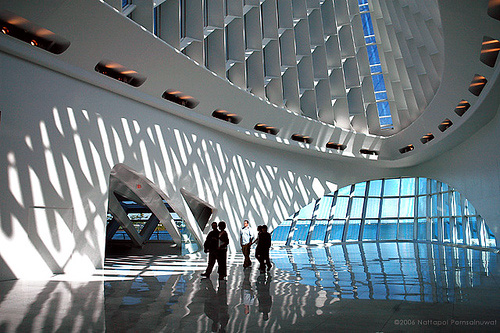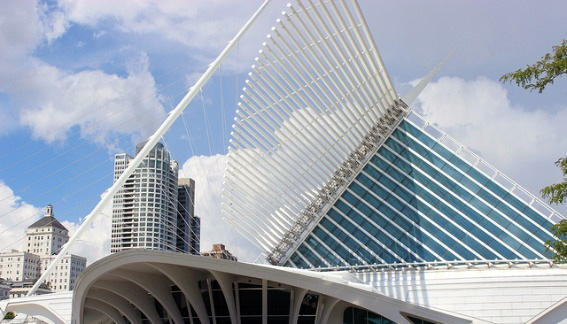
I am not intentionally trying to clickbait you into reading this article. However, for all the awards (RIBA, Pritzker, etc.) given to the “best” architect, I thought it would be refreshing to point out an architect that is unfathomably popular but has tricked the masses by producing inferior architectural projects.
Architects speaking poorly of other architects is somehow an unspoken faux paus within the profession; similar to the Emperor’s New Clothes. Whereas, publicly, architects will not criticize other architects work, even if it is contrary to their actual beliefs. (Even the Great Frank Gehry got lambasted for saying 98% of all architecture is shit).1 While many architects got into the profession seeking to emulate many “starchitects,” they eventually become jaded and disillusioned by their former idol’s contentious work, and only now criticize these architects within the confines of their own architectural circles.2
Therefore, I am initiating the inaugural Prickster Prize; awarded to the most atrocious architect. Entitled Prickster (not Pritzker), because their architecture “pricks” your nerves by being incomparably insidious. But primarily because some architects are narcissistic pricks whose dogmatic principles produce the same disgraceful products because they are too consumed with themselves.3
(If you missed Thursday’s NCAA bracket madness you can still get in on the March frenzy by casting your vote in the 2015 World’s Worst Architect Bracket).
To be eligible for the title of The World’s Worst Architect I had to set some parameters:
While Frank Gehry would be an easy target for this title due to his broad popularity and polarizing projects, I would argue that there is someone worse than the “Crumpled Tinfoil Architect”; and that man is the Bird Carcass Architect: Santiago Calatrava.
It is probably unjustly fair to put Frank Gehry as the potential foe against Calatrava as the World’s Worst Architect, when Daniel Libeskind probably make a better candidate. Gehry’s ambiguous projects lack the intentional movement of Zaha Hadid or Libeskind, but Libeskind has contrived angular projects for every project. His projects look like a shy person with little clarity, who then has ghastly loud sneezes; seemingly creating sharp, angular geometries.
If you believe any of these other architects are worse than Santiago Calatrava, then you can cast your vote in the 2015 World’s Worst Architect Bracket, but Santiago Calatrava should just stick to being a structural engineer. His bridges look amazing,4 but architects already wear too many hats. By becoming even more of a generalist, his actual architectural products become contrived amalgamations.
Many star architects have ridiculously high building budgets, but Santiago took this to the extreme by bankrupting the city of Valencia, Spain, by designing a science and technology compound5 with significant cost overruns.
Some people might argue that Zaha Hadid might be in the running for the 2015 Prickster Prize by designing curvaceous buildings that are out of scale to the human proportion.6 But Zaha’s exemplary work in the Bergisel Ski Jump, Hoenheim-Nord Terminus and Car Park, or the Evelyn Grace Academy truly does put form into motion. Unlike Calatrava who builds forms that should be in motion but remain harbored. Like this “yacht” he designed, which unfortunately is permanently docked in a reflection pool in Valencia.

Maybe if there was more than 6” of water I could finish my voyage to Roatan.
A recent Fast Company article states, “Critics blast Calatrava for wildly over-budget projects, including the World Trade Center’s new transit hub. Is he just misunderstood?”
One word: NO
Calatrava begins all of his projects with a trivial metaphor, creates a watercolor painting of that contrived idea, creates a watercolor painting of the final image, and then creates erroneous iterations to seem like the initial silly idea is paramount to his grandiose designs.

Whoops, The Madonna got obese and engulfed the Enthroned Child.
I imagine Santiago was overjoyed when Adobe Flash first was introduced. Now, instead of sketching a bird exoskeleton, and then sketching several iterations morphing the bird’s cytoskeleton into a blobby mass, all he has to do is draw a bird, draw the concocted final building, and TWEEN for a specified number of frames.
However, ARCHITECTURE IS NOT METAPHOR. Prominent buildings should have a thesis or theme carried throughout, but metaphor is impossible to experience.7
I recall going to the Moshe Safdie designed Skirball Cultural Center in Los Angeles. The facility was welldesigned, although the meeting room was designed to be a metaphor of the Tent of Abraham. This is the reason architecture is not metaphor! I wasn’t emotionally transported back in time; I didn’t feel the openness of the tent, the shaded relief from the exterior climate. All I felt was a generically designed meeting room, with a large projector, and horrendous acoustics.
Santiago Calatrava designs completely contrived metaphors. Why an eyeball? Why the symbolism of a bird in flight? Perhaps Calatrava has other degrees in Biomechanics or Anatomy; where he imagines these moving parts to transcend into built form. Unfortunately, Calatrava’s movement is almost totally of a mechanized nature of one swooping arc. Whereas Gehry has complexity within his movement, but fails to capture the dynamism of the exterior forms into intriguing interior spaces, or Zaha, whose intentional interior movements coalesce into the exterior surfaces.
However, I probably have the most vitriol towards his first American project: The Quadracci Pavilion expansion to the Milwaukee Art Museum.

The parking garage is actually the nicest feature, where the building emphasizes the cars themselves, and gives the allusion that they are the featured museum pieces. Unfortunately, the good design decisions end at the parking lot. The Pavilion itself is essentially a gigantic lobby space with no program. Many architects provide flexible programming space, but with no predetermined agenda, the prototypical lobby space becomes a vast echo-chamber wasteland.
And I haven’t even mentioned the actual iconic feature of the Milwaukee Art Museum: The Bris Soleil.8
This Bris Soleil is perhaps the worst feature. A tall lightning rod could become an icon, or a palm-tree disguised cell tower that rises above the surrounding buildings. But the bonelike structure of the “wings” are just that: the skeleton of the bird without the feathers. The Bris Soleil is supposed to function as a mechanical sunshade; if someone wanted curtains for their house, and you provide them with a fish carcass, it will create interesting shadows across one’s face, but does little for its implied intention.

I am sure it looks sculptural and graceful when in motion, but I view the actual Bris Soleil to be emblematic of Icarus flying too close to the sun; his feathers became burned and all that remained were the bone structure of his wings to aid his continued flight.
This museum received praise for increasingly the number of visitors, but just because citizens like it, it does not mean that it is good architecture, or advances the culture or the city in a positive light. The museum director’s obviously are more enamored over gimmicky ideas, than to appreciate actual thoughtful design.
Stephenie Meyer is the World’s Worst Author. She gets this title because I was intrigued by all the hullabaloo about her books, so I read the first Twilight book in an afternoon. Her writing is not explorative and her vocabulary is written at a second grade reading level. I am fine with people liking popular, yet good authors such as the incomparably talented Stephen King, or Michael Connelly. However, people who choose to read Stephenie Meyer books over superior written books, further diminish, and perhaps even set back, the advancement of culture and progression of society. I instantly think less of anyone who claims, “That they LIKE Twilight.”
This is the same reaction I have for people who appreciate Santiago Calatrava. Just because attendance to the Milwaukee Art Museum has elevated, and just because people like the imagery of the Bris Soleil, that does not make it a successful cultural icon that improves and elevates society.
A museum should focus on making art more enjoyable accessible to the public. I criticize Moshe Safdie, but his “Walmart” Museum of American Art provides visitors with an intimate setting, and doesn’t require large functions to occupy the void space devoid of programming.
Cheryl Kent wrote in her book on the architect’s Quadracci Pavilion of 1994–2001 at the Milwaukee Art Museum, “The consistent theme in Calatrava’s work is to dramatize and mystify the physics of structure.” Santiago Calatrava must be the second coming of David Copperfield, because I cannot see the greatness in his architecture, it truly is mystifying.
Footnotes:
Click the purple numerals to transport between hyperlinks
1 But he also gestured with his middle finger.
2 Then again, architects only are friends with other architects.
3 And nobody tells them otherwise.
4 Even though many renown structural engineers question whether he masks the actual supporting structure. (Mies van der Rohe would not stand for this!)
5 Or perhaps a shrine to his opulence.
6 And look like female anatomy.
7 After all, architecture is the experience of the built environment.
8 Bris Soleil is French for “non-functioning sun shade”
Calatrava suffers from the sins of arrogance, ego and excess. But in his favor, he is occasionally capable of elegance and refinement. On the other hand, Gehry and Libeskind (also arrogant and ego-driven, for sure), both take pride in being non contextual, deliberately offensive and disrespectful of history and local culture. Of the two, Libeskind is unquestionably the worst because of the outlandishly preposterous claims he makes for his work. Poor Daniel is intellectually impotent, but he is to ignorant to see even that basic truth. Blinded by arrogance, he thinks his s*#t is marmalade. He should be given the Prickster Orize automatically every year.
Ha. Perhaps.
But I would argue Calatrava’s buildings are also “non contextual, and disrespectful of history and local culture.”
I find it hard to believe that buildings in separate parts of the world, with varying cultures and local conditions, should all be based upon a bird metaphor: